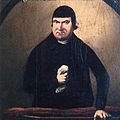History
Brighton in the late eighteenth century was turning from a fishing village to a fashionable resort, largely because of the patronage of the Prince Regent. New Road, as it is now known, was built on his instructions. The main north-south road leading out of the old town ran next to the Royal Pavilion, where he lived; noise and traffic disturbed him and made access to his stables difficult. He asked the architect of his stables to build a new road further to the west, and closed the original route. [4] New Road was pedestrianised in 2007. [5]
A congregation of Baptists with Calvinist views had been established in Brighton since the 18th century. A rift developed from 1791, when William Stevens, a newcomer, introduced Universalist views. [6] In 1793 [7] or 1795, [6] Stevens and 18 others (including the original pastor) were expelled. From 1797, a small but steadily growing congregation met at Stevens' house; by 1806 they had moved to a small chapel in Jew Street, near the Baptists' meeting place in Bond Street. A Unitarian missionary popularised the theology among the congregation, and assistance from the leader of the Unitarian community in nearby Ditchling, John Chatfield, enabled a meeting room to be bought. This opened in 1812. [6] [8]
When the Prince sold the land he owned west of New Road, the congregation paid £650 for a plot on which a new chapel could be built. Chatfield, who also made all the arrangements, donated £200. Architect Amon Henry Wilds, whose career in Brighton was just beginning, designed the stuccoed, temple-style building on the instruction of Dr Morell, a classical scholar who became the first minister at the chapel. [8]
The church was full to its 350 capacity on its opening date of 20 August 1820. [7] [8] After several changes of name, it has been known as the Brighton Unitarian Church since the 1940s. [7] [9] Now with a reduced capacity of 100, [10] there is a weekly Sunday service. [11] Rebuilding and refurbishment work was carried out in 1936, [12] 1966 [4] and 2004. [13] The roof had to be repaired after it was damaged in the Great Storm of 1987. [12]
The church is licensed for worship in accordance with the Places of Worship Registration Act 1855 and has the registration number 9189. [14]
This page is based on this
Wikipedia article Text is available under the
CC BY-SA 4.0 license; additional terms may apply.
Images, videos and audio are available under their respective licenses.





